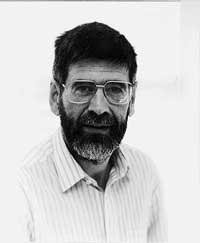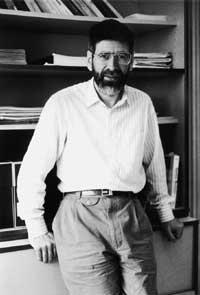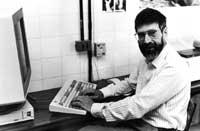Antoine Salin, biarno physicist
Last spring the prestigious physicist Antoine Salin, winner of the Peronnet-Betancourt research prize in 1993, has been working on it. We enjoyed the opportunity to be curious with biarnotan, small body and great intelligence.

Elh.- How do you explain your work situation?
A.S.- In Spain and France the research structures are different. In Spain the Higher Council for Scientific Research (CSIC) has its own laboratories and its researchers work there. In France it doesn't have to be that way. In my case, for example, although I am a researcher at the National Center for Scientific Research (CNRS), I work in university laboratories. So to speak, the CNRS is my spontaneous.
Elh.- You work in atomic physics. How would you explain to a stranger what you are doing?
A.S.- The truth is that I don't know where to start. There are many ways to explain it. We can start from the structure of the atom. The atom consists of two components: the nucleus and electrons. Each of them has its own burden. The interaction between two charges explains the cohesion of the atom. Nuclear physics studies the components of the nucleus. We study the interactions between atoms that make it possible for electrons to change state.
For example, in fluorescent tubes these phenomena occur, which occur in the layers of electrons. When the electric current passes, the atoms are ionized. The electric field accelerates some electrons. They clash with atoms and excite them. Consequently, they emit radiation, light.
Atomic physics can also be explained from an energetic point of view. The phenomena that nuclear physics studies are very energetic, like the atomic bomb. We study softer processes, from chemical reactions to final cooking. For example, we analyze the factors that influence plasma stability. Suppose there are ionized impurities in the plasma, such as the iron ions of the tokamaka wall. These can capture an electron and then emit radiation. This means a loss of energy that affects plasma stability.
Elh.- How do your research affect every day?
A.S.- Direct, nothing. We do not provide information that directly affects everyday life. We provide information to people working in applied physics. For example, to search for new laser sources it was necessary to understand the atomic excitation processes well, as this allows to predict whether the emission will occur.
Elh.- What place does atomic physics occupy in today's physics?
A.S.- Atomic physics is an ancient discipline. Atomic physics poses very simple situations. There are few elements that interact with well-known forces. This allows for high-detail theories and high-precision tests. Over the past centuries many aspects of classical mechanics were developed by analyzing the movement of stars and many of the themes of classical physics were based on celestial mechanics. Atomic physics currently works for the benefit of quantum mechanics.
Elh.- Where is physics going?

A.S.- It is a disease. As a scientist I don't like to talk about things I don't know scientifically. The specialization of scientific work is not a limit, but a necessity. You cannot know from all fields. From this perspective, we know no more from other areas of physics than from non-physicists. Of course, we want to know what's going on in other areas, but we can't get into the details.
Lately we talk a lot about astrophysics. It affects people's imagination a lot. However, I am not sure that I bring new knowledge to physics. Particle physics is in crisis. The large amount of money needed to investigate in this field leads us to think if it really is worth it.
People have a false image. He often rejects the specialist, but I think it's the only way to work. Most physicists work in seemingly humbler environments and are more important in society. Solid state physics, for example, has several applications in engineering.
Elh.- He started working with astrophysics. Now in atomic physics. From major to minor. How would you explain this evolution?
A.S.- I realized that for the realization of simulation programs of radiation transfers to the atmosphere (if we analyze the light, we can analyze the nature of the stars) people used apparent information extracted from the magician's chapel. The results were obviously different in all cases. According to my analysis this was because some basic problems were not solved.
In addition, at that time the study of the fundamental reactions between the atoms of the USA and Great Britain began. Then I started working. This has allowed me to work with physicists from different fields. Studying basic problems has allowed me to work on plasma, nuclear reaction, solid states, etc.
What have you come to the Faculty of Chemistry?

A.S.- Exchange of information. This place is famous. I knew the fame of Pedro Etxenike's team and his work and found it a good place to get to know new ideas and work.
Elh.- How did you find the environment?
A.S.- This is a meeting point. There are people who come from many villages and that creates a good research environment. Create a good atmosphere of debate. I have worked in many places and see clearly the points for and against sites like this. This, for example, does not have the dispersion that occurs in Paris. When you come to work, you have things at hand and you use time better. In Donostia you relate very easily. Reduced space is not an obstacle to research.
We will thus leave the transcript of what is treated with this physicist, concerned with scientific disclosure and the image of science in society.
Buletina
Bidali zure helbide elektronikoa eta jaso asteroko buletina zure sarrera-ontzian











